Photochemistry
 Cyanobacteria contain chlorophyll a, which is also found in plants and algae. Other photosynthetic organisms contain chlorophyll b (green algae and the plants) or chlorophyll c (dinoflagellates and photosynthetic Chromista).
Cyanobacteria contain chlorophyll a, which is also found in plants and algae. Other photosynthetic organisms contain chlorophyll b (green algae and the plants) or chlorophyll c (dinoflagellates and photosynthetic Chromista).Chlorophylls a and b differ only in the character of a group attached to the Mg-porphyrin ring moiety of the molecule: -CH3 for chlorophyll a, and -COH for chlorophyll b. Chlorophylls are embedded in the thylakoid membrane of the Cyanobacteria. (Because Cyanobacteria gave rise, through serial endosymbiotic transfers, to chloroplasts, chlorophylls are associated with the thylakoid membrane within chloroplasts in plants and Protoctista.)
Phycobilins are water-soluble pigments, so they are found in the cytoplasm of Cyanobacteria, or in the stroma of the chloroplast. Phycolibins occur only in Cyanobacteria (phycocyanin and phycoerythrin) and the "red algae", the Rhodophyta (phycoerythrin).
The overall reaction of oxygenic photosynthesis is:
6H2O + 6CO2 → C6H12O6 + 6O2
Labels: chlorophyll a, chlorophyll c, chlorphyll b, Cyanobacteria, phycobilins, phycocyanin, phycoerythrin, porphyrin ring, Rhodophyta, stroma, thylakoid membrane







































